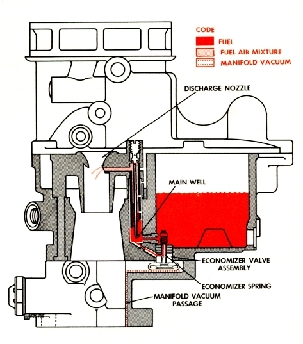
causes fuel to flow through the main
metering
system. The fuel moves up the main
well, passed
main well air bleed where air is added,
the amount
of air increasing proportionally as
the speed in
creases. This mixture of fuel and air,
being
lighter than raw fuel, has a quicker
response to
changes in the venturi pressure, and
also vaporizes
more readily than raw fuel when discharged
into
the venturi air stream. The mixture
of fuel and
air flows through the horizontal channel
and out
the discharge nozzle into the booster
venturi and
then into the air stream in the carburetor
venturi.
The throttle plates control the amount
of fuel air
mixture to the intake manifold, regulating
the
speed and power output of the engine
in accordance
with accelerator pedal movement.
6. POWER ENRICHMENT SYSTEM
During high power operation, the carburetor
must provide a mixture richer than
is needed
when the engine is running at cruising
speed under
no great power requirements. The added
fuel for
power operation is supplied by the
power enrich
ment system, sometimes referred to
as the
economizer system.
This system is controlled by manifold
vacu
um which gives an accurate indication
of the
power demands placed upon the engine.
Manifold
vacuum is strongest at idle and decreases
as the
load on the engine increases. As the
load on the
engine is increased, the throttle
plate must be
opened wider to maintain a given speed.
Manifold
vacuum is thus reduced because the
opened throt
tle plate offers less restriction
to air entering the
intake manifold.
A vacuum passage in the throttle body
trans
mits manifold vacuum to the power
valve diaphragm
in the vacuum chamber. The manifold
vacuum,
acting on the diaphragm at idle or
normal load con
ditions, is strong enough to hold
the diaphragm
down, overcoming the tension of the
power valve
spring on the stem. This holds the
valve closed.
When high power demands place a greater
loadon
the engine and manifold vacuum drops
below a pre
determined point, the power valve
spring over
comes the reduced vacuum and expands,
opening
the
power valve. Fuel from the float
chamber flows
through the valve and out the small
holes in the
sides
of the valve into the passages leading
to both main
wells. A restriction in the passage
leading to each
main well controls the amount of
fuel the power
valve meters, thus insuring an even
distribution of
fuel. In each main well, the fuel
joins the fuel flow in
the main metering system, enriching
the mixture.
As engine power demands are reduced,
mani
fold vacuum increases. The increased
vacuum
acts on the diaphragm, and the diaphragm
over
coming the tension of the power valve
spring,
moves downward. This closes the power
valve
and shuts off the added supply of
fuel which is no
longer required.
POWER ENRICHMENT SYSTEM
7.
SPARK CONTROL VALVE -
MODELS 2110-EE AND 2110-EEC
The spark control valve which is
located in
the throttle body provides an efficient
degree of
spark during periods of acceleration
by momen
tarily providing an intermediate
spark advance
curve between a fully retarded spark
and the
normal spark advance which would
be excessively
retarded when the engine is suddenly
accelerated.
The spark control valve accomplishes
this by
controlling the manifold vacuum admitted
to the
distributor vacuum line which would
bleed off the
higher, venturi vacuum at wide open
throttle.
All manifold vacuum to the distributor
passes
through the spark control valve.
Under normal
road conditions, the spark valve
is held open by a
combination of pressure; atmospheric
outside the
diaphragm, and manifold vacuum from
within. The
combined forces act against the tension
of a preset
factory calibrated spring.
When the manifold
